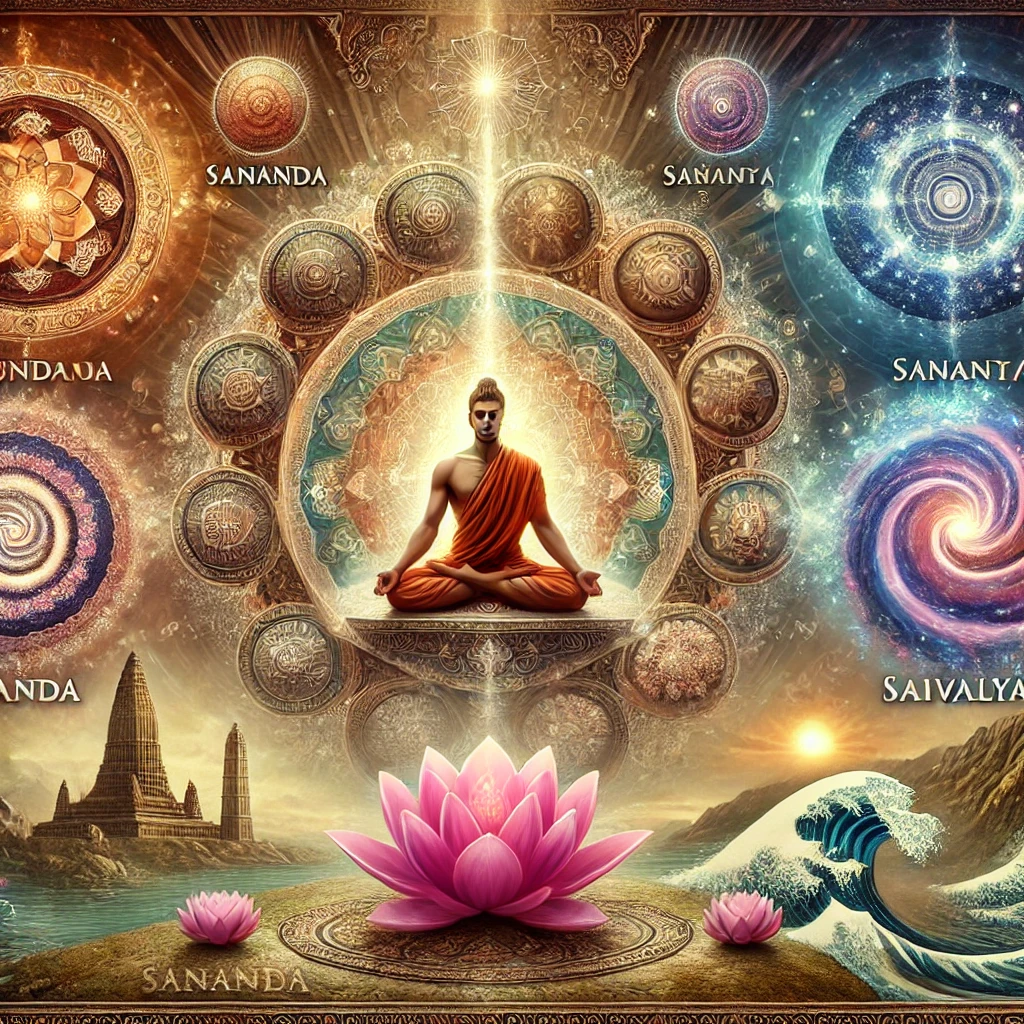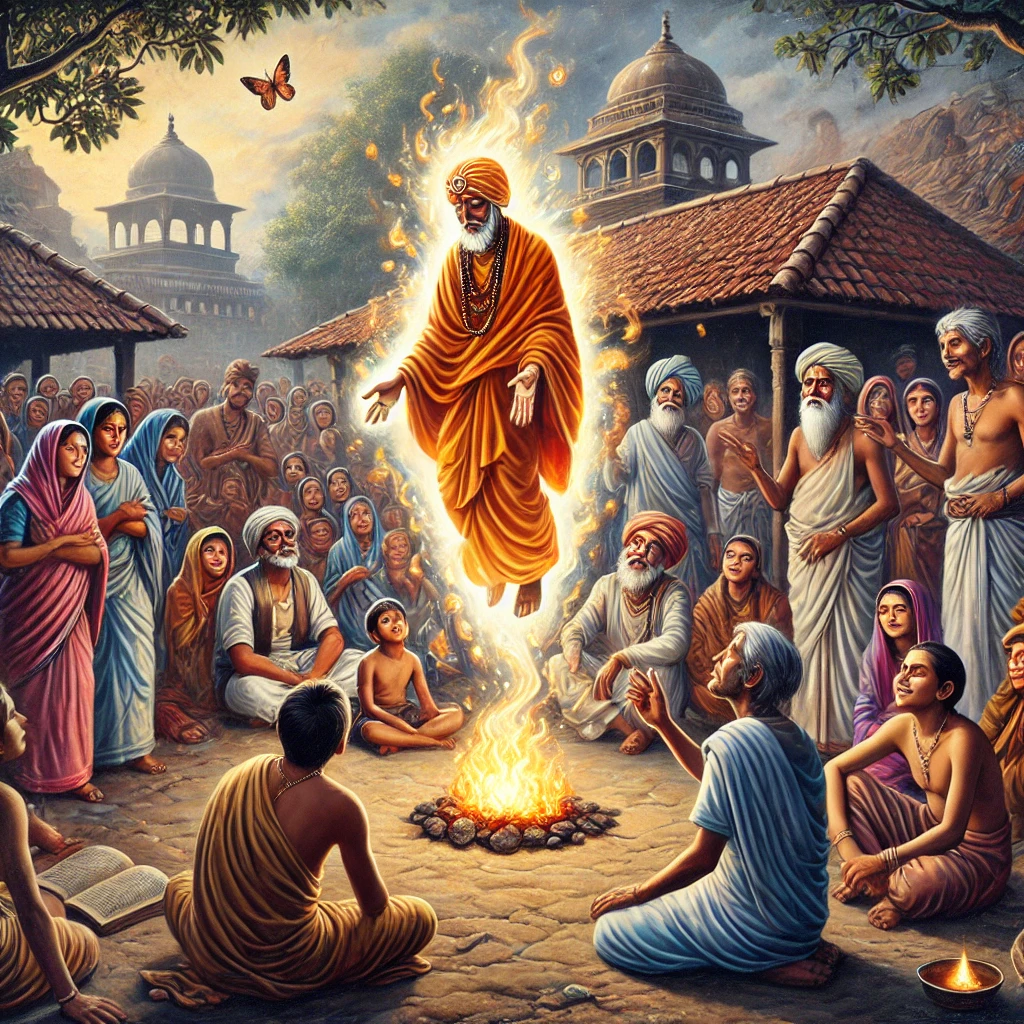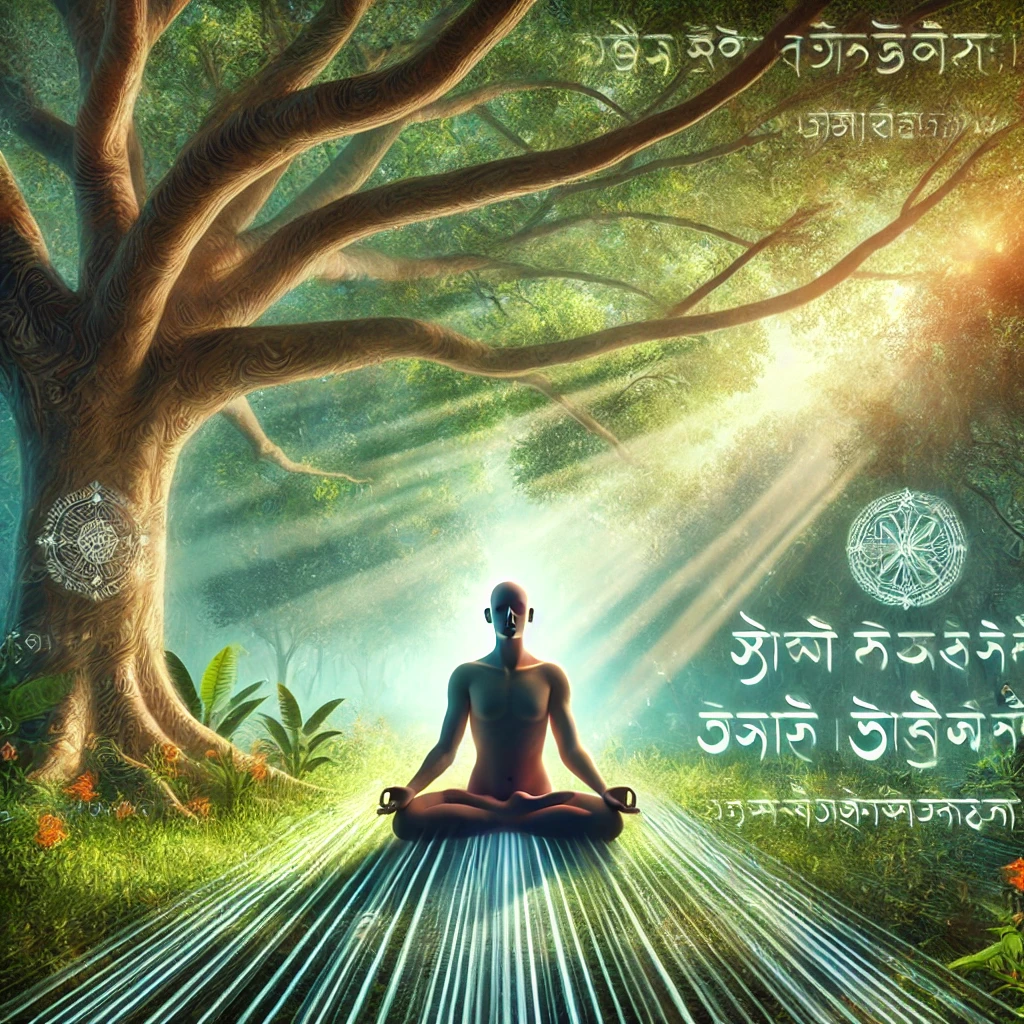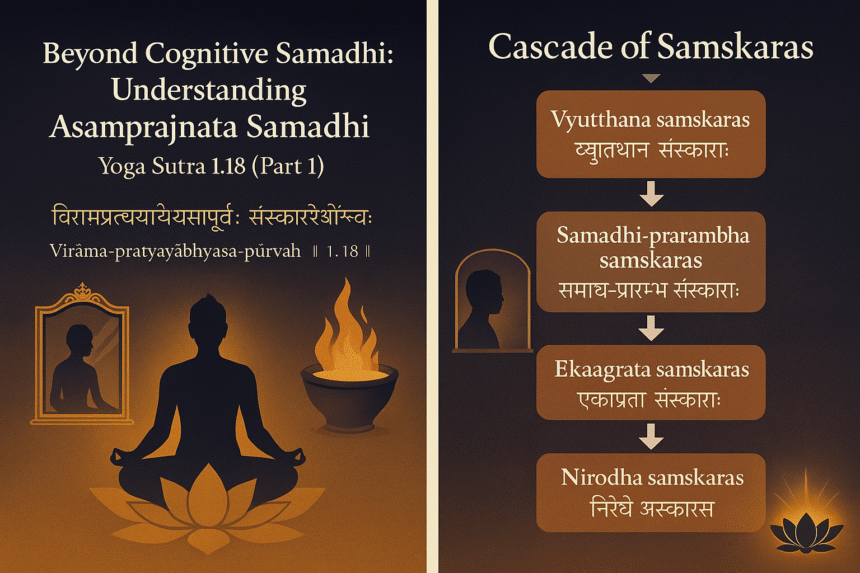Beyond Cognitive Samadhi: Understanding Asamprajnata Samadhi – Yoga Sutra 1.18 (Part 1)
Part 20: Patanjali Yoga Sutra Explained
Introduction: The Great Transition
In our previous exploration of Yoga Sutra 1.17, we journeyed through the four progressive stages of Samprajnata Samadhi:
- Vitarka (gross object meditation)
- Vichara (subtle object meditation)
- Ananda (bliss-based absorption)
- Asmita (I-am-ness consciousness)
We discovered that even at its pinnacle – Viveka-khyati (discriminative wisdom) – Samprajnata Samadhi remains within the realm of cognitive awareness. The mind still functions, though in its most refined state, perceiving the distinction between Purusha (pure consciousness) and Chitta (mind-substance).
But Patanjali doesn’t stop there. Sutra 1.18 introduces us to something radically different – a state so profound that it transcends even the highest spiritual cognition.
The Sanskrit Sutra
विरामप्रत्ययाभ्यासपूर्वः संस्कारशेषोऽन्यः ॥ १.१८ ॥
Virāma-pratyayābhyāsa-pūrvaḥ saṁskāra-śeṣo’nyaḥ
Breaking Down the Sanskrit
Let’s carefully examine each component:
विराम (Virāma)
- Root meaning: Complete cessation, stopping, ending
- Technical meaning: The cessation of ALL vrittis (mental modifications)
- Not merely: Calming or slowing of thoughts
- Rather: Complete stopping of mental activity
प्रत्यय (Pratyaya)
- Common meaning: Cause, means, instrument
- In this context: That which brings about or causes cessation
- Specifically refers to: Para Vairagya (supreme detachment)
- Alternative reading: Can also mean “cognition” or “awareness”
अभ्यास (Abhyāsa)
- Essential meaning: Practice, repetition
- Emphasis on: Continuous, sustained effort
- Not casual: Deliberate, repeated application
- Implies: Punaḥ-punaḥ anuṣṭhāna (again and again implementation)
पूर्वः (Pūrvaḥ)
- Literal meaning: Before, preceded by
- Indicates: This practice comes first as preparation
- Shows sequence: Abhyasa → Asamprajnata Samadhi
संस्कार (Saṁskāra)
- Core meaning: Impressions, latent tendencies
- Nature: Subtle traces left by experience and practice
- In this state: Only cessation-impressions remain
शेष (Śeṣa)
- Meaning: Remainder, residue, what’s left over
- Significance: Not complete emptiness, but specific remnants
- Technical point: Only nirodha-samskaras persist
अन्यः (Anyaḥ)
- Simple meaning: Other, different
- Profound implication: A COMPLETELY different category of Samadhi
- Not just: Higher or better
- Rather: Fundamentally distinct in nature

Complete Translation
“The other [type of Samadhi], preceded by the repeated practice of cessation [Para Vairagya], is that in which only the impressions [of cessation] remain.”
Or more expansively:
“Asamprajnata Samadhi – which is fundamentally different from Samprajnata – is achieved through constant practice of the cause of complete cessation of all mental modifications (namely, Para Vairagya). In this state, no active mental content remains; only the latent impressions of the cessation practice itself persist.”
The Three-Fold Structure of the Sutra
This sutra elegantly presents three essential aspects:
1. विराम-प्रत्यय (Virāma-pratyaya): The MEANS
The Method: Para Vairagya – Supreme Detachment
This is not ordinary Vairagya (which we studied in Sutra 1.15). Para Vairagya is detachment from EVERYTHING, including:
- The highest spiritual experiences
- Viveka-khyati (discriminative wisdom)
- Even the awareness of “I am conscious”
- All cognitive content, however refined

2. संस्कारशेष (Saṁskāra-śeṣa): The CHARACTERISTIC
The Sign: Only cessation-impressions remain
This defines what Asamprajnata Samadhi actually IS:
- Not a blank void
- Not unconsciousness
- Not deep sleep
- Rather: A state where active vrittis are absent but the subtle traces of cessation practice persist
3. अन्यः (Anyaḥ): The GOAL
The Achievement: Asamprajnata Samadhi – a different category entirely
This word “anyaḥ” (other) is crucial. Patanjali could have said “higher” or “better,” but instead says “other” – indicating this is not just an advancement but a categorical shift.

Understanding “Anyaḥ” – The Revolutionary Implication
Why “Other” and Not “Higher”?
Patanjali’s choice of “anyaḥ” reveals something profound about the nature of spiritual evolution in Yoga:
Samprajnata Samadhi and Asamprajnata Samadhi are not just different degrees of the same thing. They are fundamentally different KINDS of states:
Samprajnata Samadhi (Sabija – With Seed):
- Has an object of awareness
- Involves cognitive function, however refined
- Chitta is active, producing vrittis
- Gunas are in operation
- Knowledge is present
- Creates impressions
- Is Salambana (has support/object)
Asamprajnata Samadhi (Nirbija – Seedless):
- Objectless
- No cognitive function
- Chitta produces no vrittis
- Only cessation-impressions remain
- No knowledge-content
- Seeds of bondage are absent
- Is Niralambana (without support/object)
This is like the difference between:
- Ice and water (different states of the same substance) – NO
- Water and steam (still H₂O, just transformed) – NO
- Matter and energy (fundamentally different categories) – YES!
The Problem That Necessitates Asamprajnata Samadhi
Why Isn’t Samprajnata Enough?
This is perhaps the most important question. After all, in Viveka-khyati, the yogi has:
- Direct perception of Purusha
- Clear discrimination between consciousness and mind
- Transcended identification with body, senses, and ego
- Achieved profound peace and wisdom
So why go further?
The Fundamental Issue: It’s Still a Vritti
Here’s the crucial insight from the commentary:
“This too is a vritti of Chitta and is the result of the Gunas alone.”
Even Viveka-khyati – the crowning achievement of Samprajnata Samadhi – is:
- A mental modification (vritti)
- A product of Prakriti (the three gunas)
- Not the pure state of Purusha itself
- Still within the realm of subject-object duality
Think of it this way:
Looking at yourself in a mirror (Viveka-khyati in Samprajnata):
- You see yourself clearly
- You understand you’re not the reflection
- You discriminate between the real you and the image
- But you’re still looking at a reflection, not resting as yourself

Being yourself without any mirror (Asamprajnata):
- No reflection needed
- No observation happening
- No discrimination required
- Simply BEING what you are
The Mirror Analogy Expanded
The Patanjala Yoga Pradeep commentary uses a powerful analogy:
“Just as the form seen in a mirror is not the real form, similarly the perception of Atman in Chitta is not the real state of one’s own nature.”
In Samprajnata Samadhi (even Viveka-khyati):
- Chitta becomes perfectly pure (like a flawless mirror)
- Purusha reflects in it perfectly
- The yogi perceives this reflection
- There’s awareness: “I am witnessing consciousness; I am not the mind”
But it’s still a reflection!
- Subject (witness) and object (witnessed) remain
- Chitta is still functioning
- The gunas are still operating (predominantly Sattva)
- It’s knowledge ABOUT the self, not self-established-in-self
In Asamprajnata Samadhi:
- The mirror dissolves (metaphorically)
- No reflection remains
- Consciousness doesn’t perceive itself
- It simply IS itself
- Purusha established in its own nature (Svarupa-avasthiti)
Samprajnata vs. Asamprajnata: A Detailed Comparison
| Aspect | Samprajnata Samadhi | Asamprajnata Samadhi |
|---|---|---|
| Nature | Cognitive absorption | Non-cognitive absorption |
| Object | Has object (gross/subtle) | Objectless |
| Seeds | Sabija (with seeds) | Nirbija (seedless) |
| Support | Salambana (has support) | Niralambana (no support) |
| Vrittis | Present (refined) | Absent |
| Knowledge | Present (discriminative) | No cognitive content |
| Gunas | Operating (Sattva predominant) | Not producing vrittis |
| Samskaras | Multiple types active | Only cessation-impressions |
| Purusha | Reflected in Chitta | Established in own nature |
| Experience | “I know I am consciousness” | No experiencer-experience duality |
| Duration | Can be prolonged | Initially momentary |
| Bondage seeds | Weakened, not destroyed | Absent (burned) |
| Result | Leads to Viveka-khyati | Leads to Kaivalya |
The Progressive Destruction of Samskaras
One of the most fascinating aspects of this sutra is how it describes the progressive neutralization of mental impressions. The commentary provides a beautiful sequence:
The Four Types of Samskaras:
- व्युत्थान संस्कार (Vyutthana samskaras)
- Impressions of ordinary scattered mental activity
- Result of Tamas and Rajas predominance
- Keep us in normal waking consciousness
- समाधि-प्रारम्भ संस्कार (Samadhi-prarambha samskaras)
- Impressions from beginning concentration
- Result of increasing Sattva
- Lead to initial meditative states
- एकाग्रता संस्कार (Ekaagrata samskaras)
- Impressions of one-pointedness
- Result of Sattva predominance
- Create sustained deep meditation (Samprajnata Samadhi)
- निरोध संस्कार (Nirodha samskaras)
- Impressions of complete cessation
- Created by Para Vairagya practice
- Lead to and sustain Asamprajnata Samadhi
The Cascade Effect:
Each higher category neutralizes the lower:
Vyutthana samskaras
↓ (destroyed by)
Samadhi-prarambha samskaras
↓ (destroyed by)
Ekaagrata samskaras
↓ (destroyed by)
Nirodha samskaras
↓ (finally destroy themselves)
KAIVALYA
This is beautifully illustrated by the gold-purification analogy from the text:
“Just as when gold is heated in fire, the lead added to it first burns away the gold’s impurities and then burns itself away, similarly when the impressions created by cessation destroy the impressions created by one-pointedness and then destroy themselves, the cessation of this samskara-shesha is called Kaivalya.”
The Dynamic Instability of Early Asamprajnata Samadhi
Here’s something rarely discussed but crucial for practitioners:
Asamprajnata Samadhi is initially UNSTABLE.
The commentary explains:
“When the impressions of cessation weaken even slightly, the impressions of Vyutthana (ordinary mental activity) begin to strengthen, and Asamprajnata Samadhi begins to break.”
Why This Instability?
In consciousness, multiple types of samskaras coexist:
- Nirodha samskaras (cessation)
- Ekaagrata samskaras (one-pointedness)
- Samadhi-prarambha samskaras (beginning meditation)
- Vyutthana samskaras (ordinary activity)
The stronger set dominates.
In early stages of Asamprajnata Samadhi:
- Nirodha samskaras temporarily overpower others
- But they’re not yet strong enough to completely eliminate them
- When attention wavers, ordinary samskaras resurface
- The state is lost quickly
With practice:
- Nirodha samskaras strengthen
- They maintain dominance for longer periods
- Eventually, they destroy all other samskaras
- Finally, they destroy even themselves
This is why:
- Initial experiences are fleeting
- Consistent practice is essential
- One must repeatedly cultivate Para Vairagya
- Patience is crucial on this path
Conclusion of Part 1
In this first part, we’ve established:
- The fundamental difference between Samprajnata and Asamprajnata Samadhi
- Why transcendence is necessary – even Viveka-khyati is still a vritti
- The three-fold structure of Sutra 1.18
- The samskara hierarchy and how higher impressions neutralize lower ones
- The initial instability of Asamprajnata Samadhi
In Part 2, we will explore:
- Para Vairagya in depth: How to practice the cause of cessation
- The Neti-Neti method
- What it means to have “only samskara-shesha”
- The relationship between Asamprajnata Samadhi and Kaivalya
- Practical guidance for approaching this state
- Common misconceptions and pitfalls
- The progressive stabilization of Asamprajnata Samadhi
Key Takeaways from Part 1
✓ Asamprajnata Samadhi is categorically different, not just higher than Samprajnata ✓ Even Viveka-khyati (discriminative wisdom) is still a mental modification ✓ The sutra has three aspects: means (Para Vairagya), characteristic (samskara-shesha), and goal (Asamprajnata) ✓ Samskaras progressively neutralize each other in a cascade ✓ This state is initially unstable and requires persistent practice ✓ It’s called “seedless” because seeds of bondage (Kleshas) are absent
Continue to Part 2: The Practice of Para Vairagya and Path to Asamprajnata Samadhi to deepen your understanding of how to actually approach and cultivate this supreme state.
Feature Image: Click here to view the image.
Videos
Glossary of Terms
-
Asamprajnata Samadhi: The highest state of meditation in Patanjali’s Yoga Sutra where all mental modifications cease, leaving only impressions of cessation.
-
Samprajnata Samadhi: A meditative state with cognitive content or object of focus, divided into four progressive stages — Vitarka, Vichara, Ananda, and Asmita.
-
Virāma-Pratyaya: The cognition or cause of complete cessation of mental fluctuations through supreme detachment (Para Vairagya).
-
Saṁskāra-Śeṣa: The residual impressions that remain after all active mental processes have ceased in Asamprajnata Samadhi.
-
Para Vairāgya: Supreme detachment from even the subtlest experiences of bliss, knowledge, and “I-am-ness”; the gateway to Asamprajnata Samadhi.
-
Viveka-Khyāti: Discriminative wisdom that perceives the distinction between Purusha (pure consciousness) and Chitta (mind-substance); the peak of Samprajnata Samadhi.
-
Chitta: The mind-stuff composed of the three gunas (Sattva, Rajas, Tamas) that produces all thoughts and modifications (vrittis).
-
Purusha: The pure consciousness or eternal witness, distinct from Prakriti and untouched by mental activities.
-
Vrittis: The waves or modifications of the mind that create experiences and perceptions.
-
Gunas: The three fundamental qualities of nature—Sattva (balance), Rajas (activity), and Tamas (inertia)—that govern all phenomena.
-
Nirodha Saṁskāras: The impressions formed by the repeated practice of cessation, which suppress and eventually dissolve all other mental impressions.
-
Sabīja and Nirbīja Samadhi: Terms meaning “with seed” (Samprajnata) and “seedless” (Asamprajnata), referring to whether subtle impressions or supports remain.
-
Abhyāsa: Continuous and deliberate practice leading toward mental stillness and mastery over the fluctuations of Chitta.
-
Anyaḥ: The Sanskrit term meaning “other,” used in Sutra 1.18 to indicate that Asamprajnata Samadhi is a completely distinct category of absorption.
-
Kaivalya: The ultimate liberation or absolute isolation of Purusha from Prakriti, realized through the total cessation of mental modifications.
#AsamprajnataSamadhi #YogaSutra #Meditation #Vairagya #HinduinfoPedia
#PatanjaliYogaSutraExplained
Previous Blogs of the Series
- https://hinduinfopedia.org/samadhi-a-deep-dive-into-samprajnata-samadhi-and-yoga-sutra-1-17/
- https://hinduinfopedia.org/samadhi-stages-unfolded-samadhi-practice-sutra-1-17/
- https://hinduinfopedia.org/samadhi-secrets-unlocked-an-in-depth-exploration-of-yoga-sutra-1-17/
- https://hinduinfopedia.org/yoga-the-gateway-to-infinity-a-comprehensive-resource-guide/
- https://hinduinfopedia.org/yoga-beyond-gunas-attachment-unlocking-the-secrets-of-sutra/
- https://hinduinfopedia.org/yoga-renunciation-of-desires-a-path-to-inner-peace/
- https://hinduinfopedia.org/yoga-long-term-discipline-mastering-the-art-of-sustained-practice/
- https://hinduinfopedia.org/yoga-vritti-restraint-method-mastering-mindful-discipline/
- https://hinduinfopedia.org/yoga-sutra-practice-non-attachment-mastering-mind-and-embracing-tranquility/
- https://hinduinfopedia.org/yoga-sutras-memory-vritti-unraveling-the-threads-of-recall/
- https://hinduinfopedia.org/yoga-sutras-sleep-vritti-unveiling-the-depths-of-conscious-rest/
- https://hinduinfopedia.org/yoga-sutras-vikalpa-vritti-unraveling-minds-illusions/
- https://hinduinfopedia.org/yoga-sutras-viparyaya-vritti-misconceptions-and-clarity/
- https://hinduinfopedia.org/yoga-sutras-pramana-vritti-exploring-sources-of-true-knowledge/
- https://hinduinfopedia.org/yoga-sutras-five-vrittis-mastering-mind-through-ancient-wisdom/
- https://hinduinfopedia.org/yoga-and-vritti-types-navigating-mental-modifications/
- https://hinduinfopedia.org/yoga-rupe-vritti-managing-mind-modifications-through-yoga/
- https://hinduinfopedia.org/yoga-mindfulness-practices-settling-within-to-discover-true-self/
- https://hinduinfopedia.org/patanjali-and-his-ashtanga-yoga/
Follow us:
- English YouTube: https://www.youtube.com/@Hinduofficialstation
- Hindi YouTube: https://www.youtube.com/@HinduinfopediaIn
- X: https://x.com/HinduInfopedia
- Instagram: https://www.instagram.com/hinduinfopedia/
- Facebook: https://www.facebook.com/Hinduinfopediaofficial
- Threads: https://www.threads.com/@hinduinfopedia



Leave a Reply